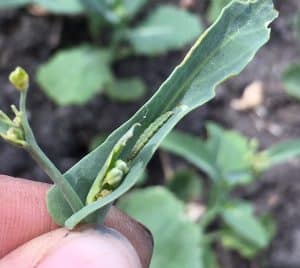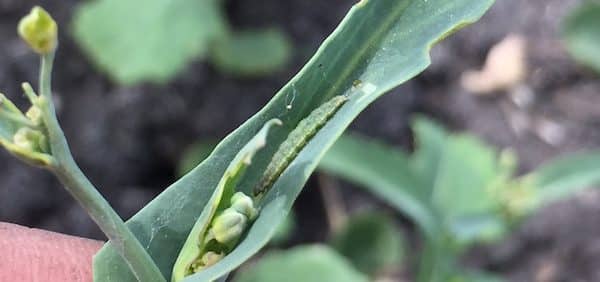Diamondback moth larvae are at noticeable levels in many canola fields in the Eastern and southern Interlake areas of Manitoba. But levels are generally below the economic threshold. People are seeing the larvae when sweeping canola, and worrying that levels are high. Yet when they do counts of larvae per ft2 of plants they are well below the economic threshold.

John Gavloski wrote the following for this week’s Manitoba Insect and Disease Update:
Sweep Net Counts and Diamondback Moth: Some have asked whether levels of diamondback moth caught in a sweep net can be used to make management decisions. There has never been a correlation established between diamondback moth caught in a net, and levels per ft2 or m2 of plants. And it may be highly variable, depending on plant stage, where larvae are predominantly feeding on the crop, etc. Last year an agronomist reported getting about 100 diamondback moth per 10 sweeps, and only about 6 per ft2 in the same area, which is well below the economic threshold. And this past week an agronomist reported getting about 15 to 20 larvae per 10 sweeps and about 2 to 4 larvae per ft2 of plants. These are observation, not replicated studies, and can’t be used to draw a correlation between sweep net numbers and numbers per ft2, from which the threshold is used. But it does show that high levels in a sweep net are not a useful means for making management decisions. What high levels in a sweep net indicate is the need to pull some canola plants, shake out the larvae, and see if you are above the threshold.
Economic threshold for diamondback moth: The nominal threshold that is used for diamondback moth in canola is that control may be required if larvae exceed 20-30 per ft2 in plants with flowers and pods. Flowering canola, however, compensates well for damage to leaves or flowers if there is good soil moisture. So except in extreme situations or drought diamondback moth management in flowering canola is rarely needed. Depending on insecticide choice, the yield boost canola gets from pollinators needs to be considered if treating flowering canola. An application at flowering if diamondback moth levels are not at or above threshold has the potential to inadvertently decrease yield if pollination is disrupted. In most instances it is best to keep monitoring levels as the canola moves into the podding stage and base management decisions on both diamondback moth levels and whether pod feeding is starting. In some years most of the larval feeding may be on the leaves, which is usually not a major concern as we move into the podding stages. In years like last year, where leaves were senescing early because of dry conditions, there may be more feeding directly to pods and potential for yield loss.
Scouting Techniques: Thresholds are based on estimating the average number of larvae that can be shaken from a foot square of plants. Instead of removing a full ft2 of plants and shaking them to count larvae, some prefer to remove individual plants, shake out and count larvae, and determine the number of plants in a square foot area on average. With some simple math it is possible to determine if the threshold is exceeded. This can work well, and may be easier in some regards. But if doing this you need to ensure plants are randomly selected, and not selected because larvae were seen on that plant. And a large enough sample size would be needed. Do this in at least 5 to 10 areas of the field is recommended.
Having something to shake plants over in the field is helpful. A beating sheet (a canvas piece of cloth on a frame) or a tray could work. In the past some have chosen to remove plants and beat them on the hood of their vehicle. This can work, but if doing this have a bucket or bag to put plants in so you are not losing larvae as you return to your vehicle.

